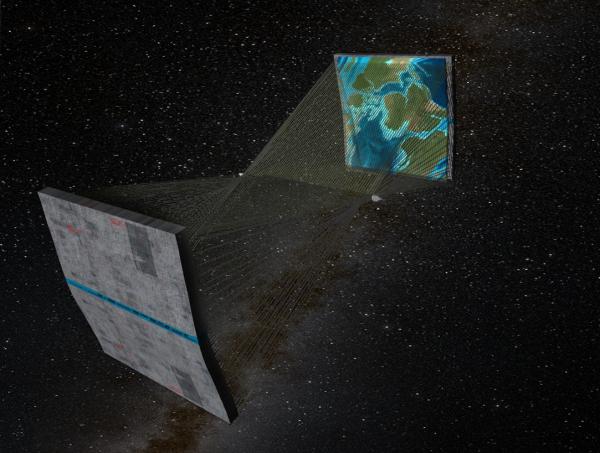BY LETTER
Flat Earth Habitats
Tethered Plate Habitats | |
 Image from Steve Bowers | |
| Square plates joined by tethers with a small microgravity hub at the centre | |
By avoiding a single contiguous pressure vessel found in conventional rotating habitats, the plates are able to avoid enormous pressure-generated hoop stresses that demand magmatter reinforcement at the largest scales. Instead, the plates only need to be locally stiff enough to resist the load of atmosphere, terrain and structure mounted atop them, which means construction of even very large plates may utilize Information Age materials, like ferrous alloys and graphite. The highest stress is instead found in the tethers joining opposite plates. The limit of nanotube tethers is a few square kilometers of plate area per tether, which either necessitates a large quantity of nanotube tethers (similar to that seen in Nieuw Amsterdam) or a sparser arrangement of magmatter-reinforced tethers.
The radius of the Flat Earth habitats is at the discretion of the builders, but several factors influence it. First, longer tethers are subject to greater strain from their own mass, just like any rotating or orbital space tether, which in turn demands a greater number of tethers to support a given plate area for increasing radii. However, this is rarely a major factor for habitats using magmatter tethers. Second, shorter tethers enforce sharper curves to the plates. In one extreme, two sufficiently large plates of sufficiently small radius would be bent to form a complete circle, thus becoming a torus. Third, longer tethers necessitate longer journeys to the opposite plate, which may be tedious when reaching the scale of Banks Orbitals.
The plates are typically tented in a manner similar to Bluesky Worldhouses, allowing excellent views of space around and above each plate. Other Flat Earth Habitats may favor Banks-style walls. Because of the habitat’s rotation, Worldhouse roofs are typically expected to assist in lighting control if the occupants are interested in day-night cycles and may be assisted by external mirrors, luminaires, sunclouds, and related technologies.
A common but not universal feature of Flat Earth habitats are hubs at the center of rotation. These vary widely in size and, like many rotating habitats, are intended to provide an easy location for visiting vessels to dock. Others may also host luminaires or mirror arrays.
The eponymous Flat Earth habitat was an MPA aesthetic effort in 4311AT to duplicate some aspects of the mythological “Flat Earth,” and thus was relatively large: each plate consisted of ten million square kilometers of land and water. Like a conventional rotating habitat, a hub was located at the center to mount spacecraft docking facilities and mirror arrays to direct local sunlight onto the plates. This hub was merely a few kilometers in diameter, which was sufficient for the amount of traffic visiting the habitat.
Because of the publicity surrounding the Mutual Progress Association’s Flat Earth, the habitats are now generally referred to as Flat Earth Habitats. Older documents refer to them as 'tethered plate' habitats, and they have be found as early as 177AT for the low Earth orbit 'Bolo' habitat, which consisted of a pair of 30-meter diameter round plates under hemispherical, transparent air tents on the ends of an 1800-meter long tether.
Related Articles
Appears in Topics
Development Notes
Text by Mike Miller
Initially published on 21 January 2016.
Initially published on 21 January 2016.






